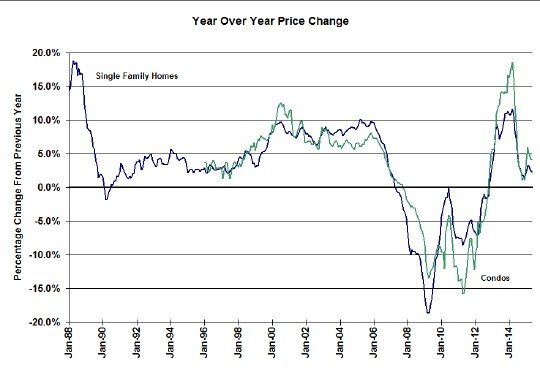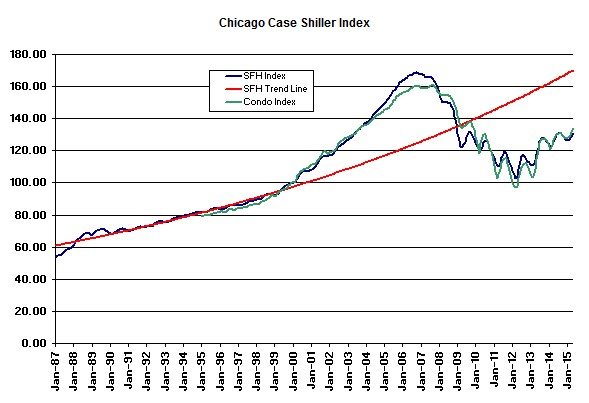After stellar home price gains in 2013 and 2014 the Chicago housing market has stalled despite near record home sales and record low inventories. Lately, each release of the Case Shiller home price index seems to show lower and lower year over year price gains. This morning the S&P Dow Jones Indices folks released the May Case Shiller Home Price Indices for the 20 metropolitan areas and the nation as a whole and it’s more of the same.
The graph below shows the sad story of shattered hopes for Chicago area housing riches. For May detached single family home prices turned in anemic year over year growth of only 2.2%, the lowest since December. Condominiums are faring better with 4% growth but that is also the lowest since December.
And when you compare the Chicago area to the other metro areas in the Case Shiller index you see that we are now tied for 3rd place….from the bottom…with Boston. The top spots go to Denver with 10% growth and San Francisco with 9.7% growth.
Of course the Chicago metro area is not a single market and there are some really vibrant areas with very nice price gains and other depressed areas that are seriously lagging. In general the highest income areas in the city are experiencing the strongest price growth.
Detached home prices in the Chicago area were up 1.3% from April while condo/ townhome prices were up 1.8%. We expect these numbers to rise at this time of the year but obviously this growth was lower than we saw at this time in the previous few years.
Looking at the long term history in the graph below you can see how much ground we’ve recovered from the lows and how much further we have to go. Detached homes have recovered 27.3% from the bottom but we’re still 22.4% below the peak. Condo and townhome prices have recovered 37.7% from the bottom and are still 16.8% from the peak.
You can tell that at the rate we are going it will be years before we get back to bubble peak pricing. In fact, detached home prices were higher than they are now during the entire period from May 2003 through January 2009. Condo prices were higher from August 2003 through December 2009.
You can also see how we continue to lose ground relative to the long term trend line in red below. The gap is now 23.1% wide.
Even at the national level home price gains have dramatically slowed from 2013 and 2014 levels. According to David M. Blitzer, Managing Director and Chairman of the Index Committee at S&P Dow Jones Indices, this is going to be the new normal for the next few years:
Nationally, single family home price increases have settled into a steady 4%-5% annual pace following the double-digit bubbly pattern of 2013. Over the next two years or so, the rate of home price increases is more likely to slow than to accelerate. Prices are increasing about twice as fast as inflation or wages. Moreover, other housing measures are less robust. Housing starts are only at about 1.2 million units annually, and only about half of total starts are single family homes. Sales of new homes are low compared to sales of existing homes.
#CaseShiller #Realestate #HomePrices
If you want to keep up to date on the Chicago real estate market, get an insider’s view of the seamy underbelly of the real estate industry, or you just think I’m the next Kurt Vonnegut you can Subscribe to Getting Real by Email. Please be sure to verify your email address when you receive the verification notice.

